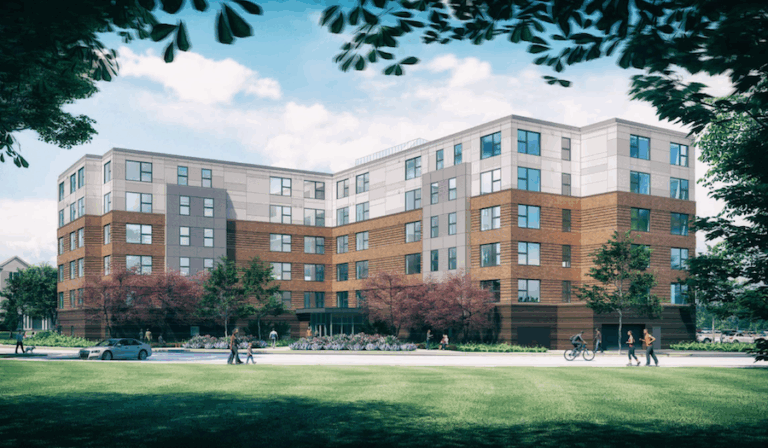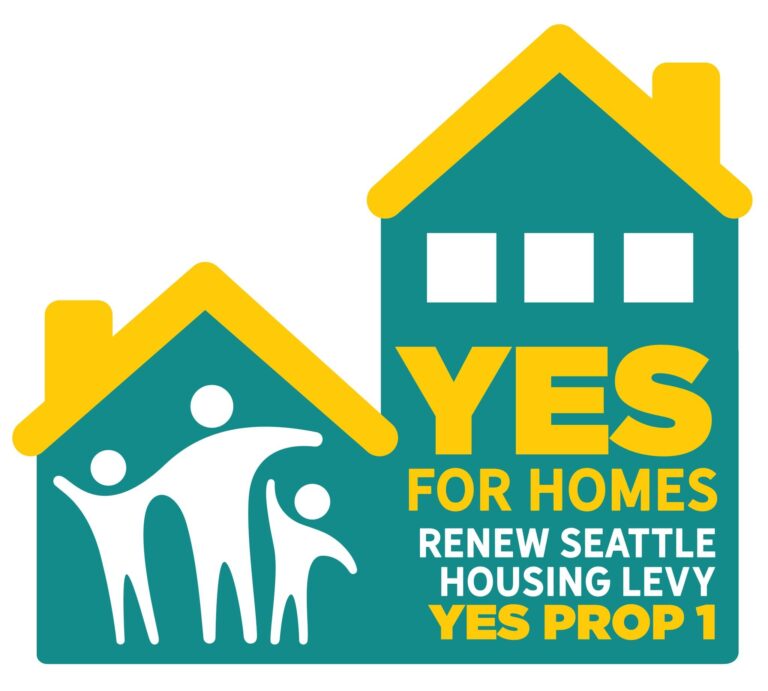Housing Ballot Measures
AUTHORS: A.J. Herrmann and Mary Ellen Wiederwohl
Key Points
- Locally sourced and controlled dollars can help provide needed funding to boost housing production. These dollars have been successfully leveraged up to 9.5X through private, philanthropic, and federal sources.
- Policymakers need to identify who has the authority to levy, collect, and spend the proposed new or expanded revenue; this will vary by jurisdiction and is often governed by state law.
- Transparency and accountability are critical, local leaders should have a clear plan and framework to determine how funding decisions will be made and community input will be solicited.
Ballot measures offer a mechanism by which elected leaders can secure a dedicated local funding source to help fill capital gaps in affordable housing developments, provide funds that abate homelessness, and support a stressed ecosystem struggling to produce and preserve affordable units, especially during periods when elevated interest rates or high construction costs might constrain private developers. These locally controlled funds are more responsive to local priorities and needs, and can often be leveraged with private, philanthropic, and, in some cases, federal dollars, making them an extremely valuable resource for local communities trying to combat the housing crisis. When combined with strategic policy choices that expand access to quality housing options for low-income renters and prospective homeowners, and aligned with outside investment, ballot measures can have a major impact in supporting the production and
preservation of affordable housing.
The Challenge This Tool Solves
As the costs of land, construction, and maintenance steadily rise, housing projects increasingly require infusions of additional capital to move forward. Without a dedicated local funding source to fill the gaps, many cities cannot produce the housing required to serve their residents, deepening an already sever affordability crisis.
Types of Communities That Could Use This Tool
Housing ballot measures could be pursued by thousands of local governments, including cities and counties, as well as at the state level. Nationally, most local governments have the authority to raise dedicated revenue via ballot measure, though whether that authority resides with city or county government, and the process which a local government must go through to put a measure on the ballot, can vary widely by state.
Expected Impacts of This Tool
Local governments have successfully leveraged public dollars up to 9.5X through private, philanthropic, and federal sources. Based on a development cost of $250,000 per subsidized unit, each $1 million raised through a local ballot measure could finance approximately 38 new homes. A $100 million bond could thus finance nearly 3,800 new homes. Costs for preservation and/or household stabilization programs often cost less, allowing these funds to stretch even further. Moreover, if deployed through a revolving loan, local funds can support even more units over the long-term, as the initial investment(s) can be redeployed into future projects as funds are repaid.
The average cost of constructing a new single-family home has increased 89% since 2017, far outpacing wage growth and inflation, and placing starter homes out of reach for many working Americans. Broader measures of construction costs for all residential buildings (inclusive of multifamily) have grown at more than twice the rate of overall inflation. Additionally, higher interest rates compound these challenges, nearly doubling the average monthly mortgage payment for a median-priced home since 2019. Without a dedicated local source of funding to help fill these gaps, many cities will struggle to produce needed housing, deepening an already acute affordability crisis.
Polling consistently demonstrates that a broad majority of Americans across geographic and political lines are concerned about the housing crisis. A national poll conducted in the fall of 2024 found that 76% of Americans believed housing affordability was worsening, with even higher concern among rural and suburban residents. Another poll conducted in the summer of 2024 found that 83% of Democrats, 71% of independents, and 68% of Republicans believed that the lack of affordable homes was a significant problem. This shared recognition and concern presents a clear opportunity for elected officials around the country to pursue local investments in housing production. Indeed, several ballot measures which called for increases in taxes to finance housing production passed in the fall of 2024, even amidst voters’ broader cost-of-living anxieties.
Seattle’s 1986 Housing Levy was the first local ballot measure passed to raise property taxes for affordable housing. Voters have renewed the levy six times, most recently in 2023. In the years since, dozens of local governments around the country have passed similar ballot measures dedicated to affordable housing production, preservation, and homelessness support services.
Meanwhile, private housing production has decreased dramatically in the wake of the 2008 financial crisis, with most new homes produced without subsidy now unaffordable for those earning at or below median income. The average starter home is now only affordable to a household making $77,000 or more a year, up from $40,000 in 2019. The median household income nationally was $80,000 in 2023, suggesting that nearly 50% of US households are unable to afford a starter home. Additionally, on a per capita basis, federal investments in affordable housing have declined since their peak in the 1970s, while construction, maintenance, financing, and insurance costs have risen, leaving more projects financially unviable without local support.
Local funding can be a critically important way for cities and local leaders to close these gaps, particularly for households earning at or below the regional median. These dollars provide flexibility, can be tailored to local needs, and are often crucial to unlocking other sources such as Low-Income Housing Tax Credits (LIHTC), private capital, or philanthropy. They also allow cities and counties to target support for specific populations, including seniors, veterans, families, or individuals experiencing homelessness.
Further, dedicated local funding sources can incentivize and channel private capital into community priorities, as developers may sometimes be willing to adjust projects to qualify for local public funding. San Antonio, for example, has leveraged the $67 million it has disbursed to date from its 2022 housing bond with $644 million in private and federal funds, with the vast majority of units (91%) affordable for households making 80% of AMI or less.


Given limited prospects for increased federal housing investment, persistently high interest rates, and elevated construction costs, local funding mechanisms will play an increasingly critical role in enabling city and state leaders to respond effectively to the housing crisis. Establishing a dedicated local funding source, especially as municipal budgets face mounting pressure, is critical. Many jurisdictions are turning to locally authorized revenue and financing mechanisms, including ballot measures (also referred to as a referendum or referenda). Approved by voters, these tools can help cities and counties bridge capital gaps in housing production and preservation. Moreover, some communities may want to further use these voter-driven measures to fund homelessness initiatives and operating support for local housing agencies and programs.
Local governments are already deploying a range of investment strategies to support housing Proposed Solution: Housing Ballot Measures production and preservation. Common tools include tax abatement and/or tax increment financing to “close the gap” in the capital stack for otherwise unviable development projects. Many local governments are providing land at no cost or low-cost long-term land leases. Some localities are dedicating a portion of their annual bonding capacity or a portion of general fund revenue to local housing trust funds or similar programs dedicated to housing production and preservation. Given the widening gap between the cost to preserve and develop housing and the available resources, however, new tools are required.
Voter-approved ballot measures can establish a stable local funding source for housing, untethered from the whims and pressures of an annual budget process or the local political cycle. The longterm reliability can also make it easier to attract federal matching dollars as well as private capital from developers and investors, who can be assured there is a dedicated and secure local revenue source that they can leverage. Finally, consistent funding can help build capacity in local housing service providers and nonprofit developers, who otherwise may be dependent on limited allocations from federal programs such as the LIHTC, the HOME Investment Partnership Program, and/or Community Development Block Grants (CDBG).
Here, we highlight key steps that cities can take to pursue a housing ballot measure campaign. While the process must be tailored to each community’s needs, and legal and political context, these general principles provide a starting point for action.
Plan Development
The foundation of a successful housing ballot measure is a clear and compelling case for investment. Local leaders must first identify and define a set of challenges or opportunities the proposed funding would address. This begins with asking: What housing intervention(s) does my community need? What specific funding gaps or challenges are we trying to address? What is the scope/scale of the problem/challenge measured against local revenue options and budget/bonding availability? Answers to these questions might include supporting new housing developments for rent or sale, providing funds for the operating budgets of existing affordable housing providers, preserving existing affordable units, paying for the increasing demands on city budgets and local nonprofits for supportive housing and services for the homeless, or some combination of these efforts. These questions should initiate an active listening campaign with the community and key stakeholders that helps to inform the plan development.
The process itself is important. Incorporating community input about housing priorities during the needs assessment phase demonstrates that local elected leaders are responsive to the community’s needs. The translation of community feedback into an actual plan enables more robust investments, and the engagement process itself fosters a ready-made coalition, and community buy-in, that will be essential to a successful campaign. The public wants to know what they are buying with their tax dollars, who is spending it, and how they will be sure they got their money’s worth. Voters are looking for clarity and transparency. Local leaders will benefit from implementing robust communications and spending transparency measures such as “open checkbooks” and community oversight boards. Engage community early and stay close throughout plan development, campaign, and implementation.
Furthermore, community-informed, data-driven housing investment strategies allows organizers to address questions and concerns about displacement and gentrification. Voters may be skeptical that new investments in housing will benefit them directly and worry that enhanced local support for development projects may exacerbate existing financial pressure in the housing market. This challenge is also an opportunity to demonstrate how targeted investments can stabilize neighborhoods, increase housing choices, and prevent displacement. Local officials can work with community members to design local programs and funding support that both make better policy and help build a broad coalition to support the initiative.
The plan development process should clearly delineate which types of projects will be eligible for support from the measure, and how the funds will be used to support those projects. Common categories of funding include:
- Production of new rental housing, typically affordable for households at or below median income, with priority given to lower levels of income;
- Preservation of existing affordable rental housing, particularly ones that are at risk of losing federal support through programs such as LIHTC (i.e., rolling off affordability requirements);
- Homeownership support, including down payment assistance, often working in collaboration with local nonprofits and/or Community Land Trusts;
- Home repair programs and/or tenant assistance that allows at-risk households to remain in their homes;
- Homeless support services and the construction of temporary and permanent support housing for the chronically homeless; and
- Operating support for city staff and nonprofit partners to administer the proceeds of a ballot measure.
The plan development stage must also define key governance and implementation parameters, such as:
- Will funds only be used to support households at or below a certain level of income?
- Will funds only be used for housing production or preservation (capital dollars), or are support services (operating dollars) also eligible?
- Who will decide how funds are allocated and which projects are prioritized? An existing city agency such as a Housing Department? A locally established Housing Trust Fund? An independent Board appointed by an elected official? What role will elected officials such as City Council members have in ratifying or approving these recommendations?
- How much funding needs to be raised, and over how long a time period will that funding be authorized?
- How will the public be informed about the ongoing revenue and expenditures? How will local elected leaders ensure a transparent and accountable process?
Authorizing the Ballot Measure
Policymakers need to identify who has the authority to levy, collect, and spend the proposed new or expanded revenue; this will vary by jurisdiction and is often governed by state law. In some states, localities are limited by their state constitutions on what they can and cannot pursue locally in terms of certain taxes or ballot measures. Other states or localities have restrictions on public dollars being used for private benefit, which could preclude funding from going to programs that benefit homeowners or private developers. Local leaders can benefit from examining the experiences of peer localities within their state that have already pursued housing or similar ballot measures.
In some cases, local leaders may need to pursue new state legislation to authorize their ability to even pursue a local ballot measure or to authorize new intermediaries with the power to manage and implement the proceeds from an initiative. For example, the California State Legislature authorized the creation of the Los Angeles County Affordable Housing Solutions Agency (LACAHSA) in 2022 to provide better coordination of affordable housing and homeless support programs across LA County. LACAHSA will receive and oversee 36% of the proceeds from LA County’s recently passed, estimated $1.1 billion annual affordable housing initiative (Measure A), with remaining proceeds to be allocated to individual cities within LA County based on the relative size of their unsheltered homeless populations.
Additionally, local leaders must understand the process for placing the measure on the ballot. Specifically, which legal entity (e.g., City Council, County Commission) can authorize a measure to go on the ballot – and/or is there a local petition process by which residents can place a measure on the ballot? Further, in some states, there may be different voter approval threshold depending on how a measure gets on a ballot; for example, in California, some measures placed on the ballot by petition require voters to approve by a two-thirds vote whereas measures placed on the ballot by a representative legislative body (like a County Commission) only require 50+1% approval by voters at the ballot box to become law.
The wording of the ballot measure itself is also critical. Some states impose strict requirements on ballot language, while others provide broader flexibility. Regardless of the jurisdiction, the specific language used can significantly influence public perception and voting behavior. Legal counsel should be consulted early to ensure compliance and maximize clarity. Finally, state and local laws may limit when a measure can be placed on the ballot. Some jurisdictions require that ballot measures accompany local elections while other places may allow stand-alone elections. Understanding this legal reality is accompanied by a political reality, timing can have a significant impact on the measure’s performance. For example, many ballot measures tend to perform better during higher turnout elections like a Presidential year; however, there are plenty of local examples of measures that succeeded as stand-alone elections in March or August. Success depends on understanding the local context, voter sentiment, and aligning campaign timing and strategy accordingly.
Local leaders should engage legal counsel such as a city or county attorney early in the plan development process on questions pertaining to the requisite authorities necessary for the ballot measure. Local leaders should request a clear legal memorandum from local legal authorities that spells out “who” has the authority to place the measure on the ballot, the timing, the process, and any prerequisites (i.e., financial plans, cost-benefit analyses, tax projections, etc.); further, legal advice should be provided on how the taxes will be levied, collected, reported, and audited. In some cases, existing bodies within local, regional, or state government are charged with the implementation of the plan, but in other cases, a new agency or department may be created.
Organizing and Executing an Effective Ballot Measure
Placing a measure onto the ballot is only one step in the broader effort to secure and leverage new local housing funds. As noted earlier, robust community engagement is a critical element to the plan development process, and community input should be solicited and received during all parts of the planning, organizing, and execution process. It is important to remember that the core elements to the process – designing a plan, engaging the community, understanding the political environment, and convincing voters – are interconnected, and should be pursued in tandem.
During the plan development process, local elected leadership should be building strong relationships with a broad range of stakeholders who will be key to organizing and winning the campaign for new funds, including housing advocates, local developers (for-profit and nonprofit), business leaders, neighborhood organizations, tenants’ unions, and more. Anyone invested in the future of the community is a potential ally. These stakeholders are critically important community advocates, and can serve multiple roles:
- As trusted validators within their networks and beyond;
- As public educators, which is particularly important for 501(c)(3) nonprofit stakeholders, which cannot politically campaign but can inform; and
- As funders and/or supporters of the formal political campaign.
Ballot measures do not pass on good ideas alone. Even with unanimous City Council support or mayoral backing, housing measures require a formal, professional campaign, just like a candidate race. This means creating a staffed advocacy operation with clear leadership, fundraising capacity, and voter engagement strategies. The ballot measure itself should have strong connections to a local and vocal elected official or trusted community leader, be it a mayor, county commissioner, council member, pastor, etcetera.
When setting up the campaign, the first step involves establishing the legal entities to manage and advocate for the policy measure, and often includes both local 501(c)(3) and 501(c)(4) organizations. It’s usually necessary to create both because some funders will only give to a (c)(3), and a (c)(3) organization can do a lot to educate the public on the measure. A (c)(4) organization, and/or ballot committee (depending on state election law) is needed to do the true campaigning, like direct mail, online ads, and television ads.
A notable example of this is Austin, TX, where HousingWorks Austin, a 501(c)(3) organization, was established in 2006 with the mission of increasing the supply of affordable housing in Austin by providing research, education, advocacy, and workable policy recommendations. Local advocates and Housing Works have also organized a separate 501(c)(4), Keep Austin Affordable, which has provided direct campaign support for local ballot measures to fund affordable housing programs in 2018 and 2023.
So, you have your plan developed, you know your pathway to the ballot, and you’re setting up your education and advocacy structures with new local organizations who are going to support your campaign to win at the ballot box. Let’s talk about “how” you win. While the communications strategy will vary by community and proposal, there are standard winning persuasion messages. Messaging should be designed to appeal to the full electorate, not just those who may directly benefit from the proposed investments. For example, testing for Rhode Island’s recently passed $120 million statewide bond initiative showed that voters reacted more favorably to broader messaging around the importance of providing affordable options housing for all state residents, especially families with children and low-wage workers, as opposed to messaging more directly focused on increasing housing costs. Similarly, supporters of Ingham County, MI’s housing initiative, which passed in November 2024, highlighted how the referenda would be used to support affordable housing in rural areas, not just in Lansing, the state capital and the county’s largest city. They also highlighted how some of the proceeds from the millage would be used for small and workforce development programs for homebuilders and developers, making it easier for them to access other federal and state housing programs and bringing additional investment into the region.
Second, accountability is key, and voters want to know that their money will be well spent. Advocates for Los Angeles’s Measure A stressed how the proceeds of the measure would be tied to clear and specific metrics and outcomes. Los Angeles Mayor Karen Bass specifically appealed to this in advocating for the Measure at a press conference in October, telling reporters: “Money will be taken away from programs that do not deliver results…I want to make it clear that I mean business, and Measure A means business.” Other advocates stressed that the accountability measures included in Measure A were directly developed from lessons learned from previous affordable housing efforts. Tying ballot measures to outcomes and specific metrics builds public trust.
Third, the most persuasive part of a proposal is not always the biggest piece of it. Taking an example from another issue area, in the recent Nashville transportation referendum, one of the smaller proposed expenditures by dollar amount was traffic light synchronization, but it was clearly the most popular component of the ballot measure for voters. Campaign leaders should not let the division of spend in the proposal dictate the strategy, but rather what resonates with community.
Since all politics is local, campaigns must be tailored to local political dynamics. One community that desires faster economic growth may find that voters are swayed by economic development messaging. In another community that is experiencing the pain of fast growth, similar messaging may encounter resistance. The (c)(3) or (c)(4) organization should conduct polling and qualitative research (e.g., focus groups) early and often in the process to really understand voter sentiment and opinions. What messages are appealing to voters? Why would they vote yes?
Housing campaigns offer a different set of voter sentiment variables than other “capital” ballot measures where voters can more likely see their dollars going to their personal use – i.e., using a new road from a transportation measure or enjoying new parks/libraries from a local quality of life referendum. Based on current experience, housing campaigns are probably most analogous to ballot measures seeking to increase funding for transit. Only a small percentage of the population uses transit on a regular basis, and successful ballot measure campaigns for transit have to figure out how to message to voters who will perhaps never use the service they are voting to increase their taxes to fund. Similarly, with local housing ballot measures, voters are asked to raise their taxes to pay for housing they will be unlikely to live in. Messages must broadly appeal to local voters and the community’s vision for being a great place to live.

Case Study
Seattle, WA, Seattle Housing Levy (most recently 2023)
Housing Ballot Measures
First authorized in 1986, the Seattle Housing Levy has been renewed six times by city voters, most recently in 2023 by a 69-31 margin.
Read More About Seattle, WA, Seattle Housing Levy (most recently 2023)
Case Study
San Antonio, TX, Measure F (2022)
Housing Ballot Measures
In 2022, San Antonio voters passed Measure F, dedicating $150 million to affordable housing as part of a six-initiative package that totaled over $1.1 billion for a number of civic needs.
Read More About San Antonio, TX, Measure F (2022)
Case Study
Los Angeles, CA (Measure A in 2024, Measure HHH in 2016)
Housing Ballot Measures
In 2024, Los Angeles County voters approved Measure A, a half-cent sales tax measure that would raise an estimated $1.1 billion annually for homeless services and affordable housing, with no sunset date.
Read More About Los Angeles, CA (Measure A in 2024, Measure HHH in 2016)
Case Study
Ingham County, MI (Lansing), 2024
Housing Ballot Measures
Demonstrating that housing ballot measures can also succeed in less populated and more rural jurisdictions, Ingham County, MI, which includes Lansing, passed a housing and homelessness millage in 2024 by a margin of 62-38, with proceeds going to the County’s Housing Trust Fund.
Read More About Ingham County, MI (Lansing), 2024
Case Study
Colorado, Prop 123, 2023
Housing Ballot Measures
Colorado’s Proposition 123, a $300 million statewide initiative which passed in 2022, created the state’s first dedicated funding stream for affordable housing.
Read More About Colorado, Prop 123, 2023
Case Study
Denver Measure 2R, 2024
Housing Ballot Measures
Oftentimes as many lessons can be drawn from failed ballot measures as from ones that succeeded. Denver’s Measure 2R would have increased the city’s sales tax by 0.5%, generating an estimated $100 million a year in new annual revenue to support housing production through 2064.
Read More About Denver Measure 2R, 2024Diffusion and Scaling of Housing Ballot Measures
While housing ballot measures are gaining traction, they remain less common than those focused on transit and local quality-of-life improvements. In 2024, local and state voters considered 53 measures to raise or preserve local revenue for affordable housing, less than half of the estimated 120 transportation and infrastructure related measures that state and local voters considered last year. This gap suggests opportunities exist to greatly expand the use of housing
ballot measures as a tool to promote local investment in housing production.
Nationally, we need to build better intermediaries and coalitions to help support local communities in planning and launching housing ballot measures. The National Low Income Housing Coalition produces resource guides to aide local officials in designing ballot measures and annual reports cataloging the success of local and state housing-related ballot measures nationally; however, there is not currently a nationally focused organization that provides direct TA and support to cities and states in this area. As corollaries, Accelerator for America’s 501(c) (4) sister organization Accelerator for America Action provides support to localities for transit and transportation measures, and the Trust for Public Land has long provided similar support across the country for parks, trails and land conservation initiatives. These examples demonstrate the potential impact of targeted, strategic support for local ballot measures.
Discussions have begun about expansion of these kinds of efforts for the explicit purpose of providing direct support to states, counties, and cities for housing ballot measures and to serve as a resource hub for national best practices and lessons learned. These efforts can revolutionize how communities approach housing challenges, providing them with the tools, knowledge, and support needed to make meaningful local investments in affordable housing. The opportunity is substantial. Relatively modest investments to support capacity in these organizations could potentially unlock billions of dollars in local funding to support affordable housing. By fostering collaboration, building coalitions, and equipping local leaders with the tools they need, policymakers have an opportunity to expand the use of housing ballot measures as a powerful mechanism for addressing one of the nation’s most pressing challenges.
